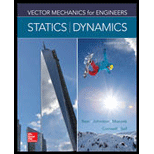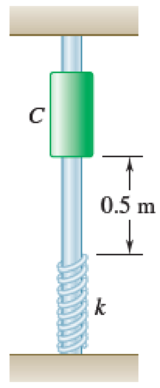
Concept explainers
A 5-kg collar C is released from rest in the position shown and slides without friction on a vertical rod until it hits a spring with a constant of k = 720 N/m that it compresses. The velocity of the collar is reduced to zero, and the collar reverses the direction of its motion and returns to its initial position. The cycle is then repeated. Determine (a) the period of the motion of the collar, (b) the velocity of the collar 0.4 s after it was released. (Note: This is a periodic motion, but it is not simple harmonic motion.)

Fig. P19.15
(a)
The period
Answer to Problem 19.15P
The period
Explanation of Solution
Given Information:
The mass (m) of the collar C is 5 kg.
The spring constant (k) is
The value of acceleration due to gravity (g) is
The vertical distance (h) between the collar and the spring is 0.5 m.
Calculation:
Calculate the natural circular frequency
Substitute
Calculate the initial velocity
Substitute
Calculate the free fall time
Substitute
Measure the displacement (x) from the position of static displacement of the spring.
Calculate the weight (W) of the collar C using the relation:
Substitute 5kg for m and
Calculate the static displacement
Substitute
Show the displacement of the collar and spring while impact as in Figure (1).

Write the equation of motion for simple harmonic motion as below:
Substitute 5 kg for m and
Write the expression for displacement (x):
Differentiate the above equation.
When time (t) is 0 the displacement (x) is equal to
Substitute 0 for t and
Rewrite the above equation,
Substitute 0 for t,
Calculate the phase angle
Substitute
Calculate the amplitude
Substitute
Hence, from time of impact, the ‘time of flight’ is the time necessary for the collar to come to rest on its downward motion. The time required for collar to rest return is
At time
Calculate the time
Substitute 0 for
Substitute
Calculate the period of motion
Substitute
Therefore, the period
(b)
The velocity
Answer to Problem 19.15P
The velocity
Explanation of Solution
Given Information:
The mass (m) of the collar C is 5 kg.
The spring constant (k) is
The value of acceleration due to gravity (g) is
The vertical distance (h) between the collar and the spring is 0.5 m.
Calculation:
Calculate the velocity
Rewrite equation (2).
Substitute
Therefore, the velocity
Want to see more full solutions like this?
Chapter 19 Solutions
Vector Mechanics for Engineers: Statics and Dynamics
- Determine the natural frequency of the spring- mass system in both radians per second and cycles per seconds (Hz) k = 9.72 kN/m 30 kg Own wn = 2.86 rad/s and fn Own = 0.09 rad/s and fn Own = 0.57 rad/s and fn Own = 18 rad/s and fn =arrow_forwardQ3: A machine component of mass 2 kg moves with SHM of amplitude 250 mm and periodic time 3s. determine (a) the maximum velocity, (b) the maximum acceleration, (c) the acceleration and the force acting on the component when it is 50 mm from the central position.arrow_forwardA 4-lb weight is attached to a spring having a stiffness k = 10 lb/ft The weight is drawn downward a distance of 4 in. and released from rest. If the support moves with a vertical displacement in , where t is in seconds, determine the equation which describes the position of the weight as a function of time.arrow_forward
- The system shown below consists of a uniform disk D that has a mass of mp = 3.0 kg and a radius of r = 0.5 meters. The disk is connected by a massless cable to a block. The system is released from rest and the disk starts rolling without sliding with the angular acceleration of a = 24 rad in the clockwise direction. Determine the tension developed in the cable (in Newtons) at this instant. Consider 0 = 30° and g 10 * mparrow_forwardA spring with a spring constant of 1200lbf/ft is attached to block with a mass of 96.6lbm horizontally. It was initially displaced 3 inches to the left of the equilibrium position and released at 12in/s going to the right. Determine also the b) velocity 2 seconds after the push in ft/s *arrow_forward1 sec A block-spring system has a maximum restoring force Fmax = 0.1 N. If the amplitude of the motion is A = 0.16 m and the mass of the block is m = 100 g then the angular frequency w is equal to O 1.25 rad/s 20 rad/s 5 rad/s 2.5 rad/s O 10 rad/s A simple pendulum is set into motion at two different times with different initial conditions, The first time: the bob is in its equilibrium position and is given anarrow_forward
- A simple pendulum is set into motion at two different times with different initial conditions. The first time: the bob is in its equilibrium position and is given an initial velocity + 2 m/s. The maximum height reached by the bob is h1,max and the period of motion is T1. The second time: the bob is in its equilibrium position and is given an initial velocity + 4 m/s. The maximum height reached by the bob is h2.max and the period of motion is T2. Assume that the motion is simple harmonic which oh the following is truearrow_forwardA simple pendulum is set into motion at two different times with different initial conditions. The first time: the bob is in its equilibrium position and is given an initial velocity + 2 m/s. The maximum height reached by the bob is h1,max and the period of motion is T1. The second time: the bob is in its equilibrium position and is given an initial velocity + 4 m/s. The maximum height reached by the bob is h2,max and the period of motion is T2. Assume that the motion is simple harmonic, which of the following is true? h2,.max = 4h1,max and T, = 2T, Then we have: h2.max = 9h1,max and T2 = 3T,arrow_forwardR A body with a weight of 5 pounds force hangs from a spring with constant 8/5 Ib/ft. The medium in which the body moves offers a force of resistance to movement that is numerically equal to its instantaneous velocity. If the weight is released 5/6 feet above its equilibrium position with a downward velocity of 24 feet per second, determine the time in which it passes through the equilibrium position. Consider negative downward and positive upward magnitudes.arrow_forward
- The system shown below consists of a uniform disk D that has a mass of mp = 3.0 kg and a radius of r = 1.0 meters. The disk is connected by a massless cable to a block. The system is released from rest and the disk starts rolling without sliding with the angular acceleration of a = rad 30 s2 in the clockwise direction. Determine the magnitude of the friction force (in Newtons) developed between the disk and the inclined surface at this instant. Consider 0 = 40° and g = 10 m. mparrow_forwardFor the system below, determine the equation of motion using Lagrange's equation. mr 2k 2m 2k m 2m marrow_forwardTwo bodies of masses 10 kg and 15 kg are hung from the ends of an extensible rope passing over a frictionless pulley. If masses of both the bodies are doubled, the acceleration of the system will also be doubled. Select one: O True O Falsearrow_forward
 Elements Of ElectromagneticsMechanical EngineeringISBN:9780190698614Author:Sadiku, Matthew N. O.Publisher:Oxford University Press
Elements Of ElectromagneticsMechanical EngineeringISBN:9780190698614Author:Sadiku, Matthew N. O.Publisher:Oxford University Press Mechanics of Materials (10th Edition)Mechanical EngineeringISBN:9780134319650Author:Russell C. HibbelerPublisher:PEARSON
Mechanics of Materials (10th Edition)Mechanical EngineeringISBN:9780134319650Author:Russell C. HibbelerPublisher:PEARSON Thermodynamics: An Engineering ApproachMechanical EngineeringISBN:9781259822674Author:Yunus A. Cengel Dr., Michael A. BolesPublisher:McGraw-Hill Education
Thermodynamics: An Engineering ApproachMechanical EngineeringISBN:9781259822674Author:Yunus A. Cengel Dr., Michael A. BolesPublisher:McGraw-Hill Education Control Systems EngineeringMechanical EngineeringISBN:9781118170519Author:Norman S. NisePublisher:WILEY
Control Systems EngineeringMechanical EngineeringISBN:9781118170519Author:Norman S. NisePublisher:WILEY Mechanics of Materials (MindTap Course List)Mechanical EngineeringISBN:9781337093347Author:Barry J. Goodno, James M. GerePublisher:Cengage Learning
Mechanics of Materials (MindTap Course List)Mechanical EngineeringISBN:9781337093347Author:Barry J. Goodno, James M. GerePublisher:Cengage Learning Engineering Mechanics: StaticsMechanical EngineeringISBN:9781118807330Author:James L. Meriam, L. G. Kraige, J. N. BoltonPublisher:WILEY
Engineering Mechanics: StaticsMechanical EngineeringISBN:9781118807330Author:James L. Meriam, L. G. Kraige, J. N. BoltonPublisher:WILEY





